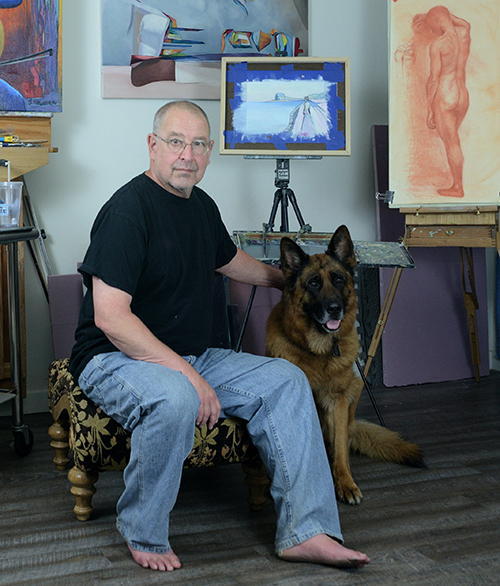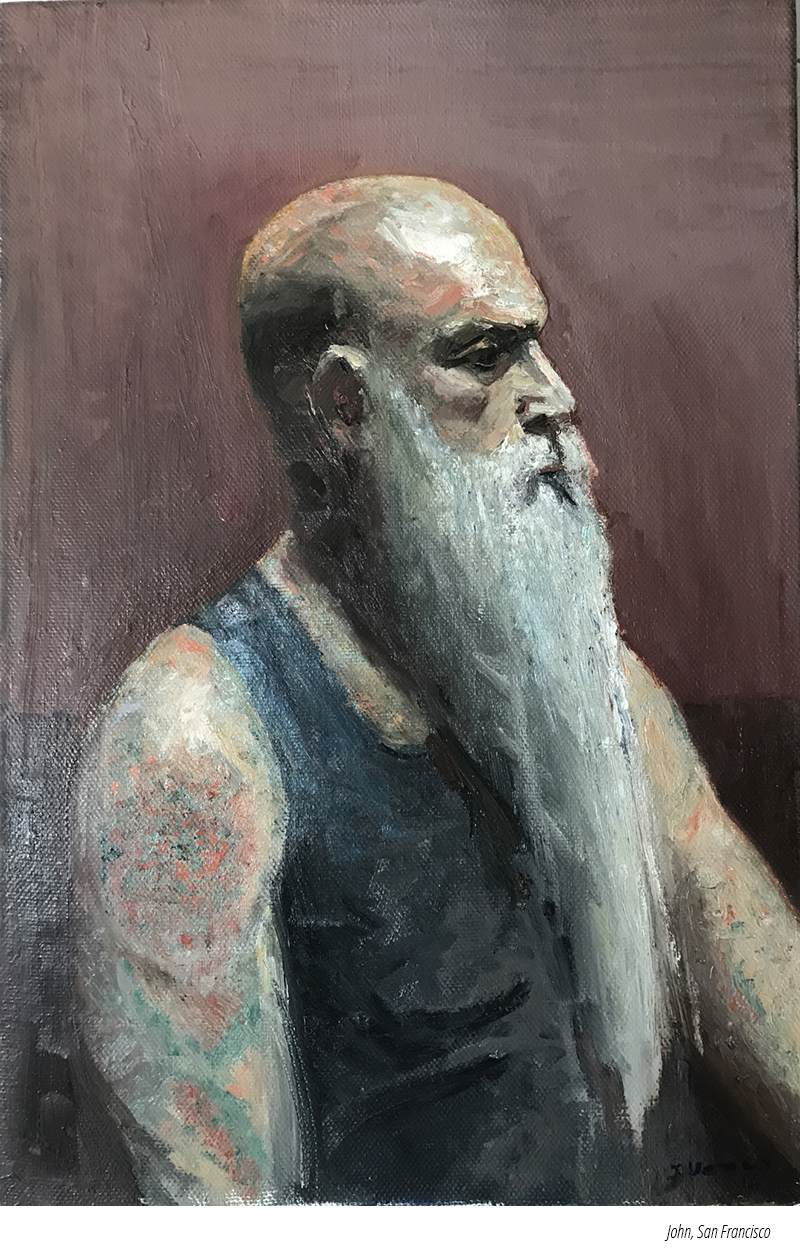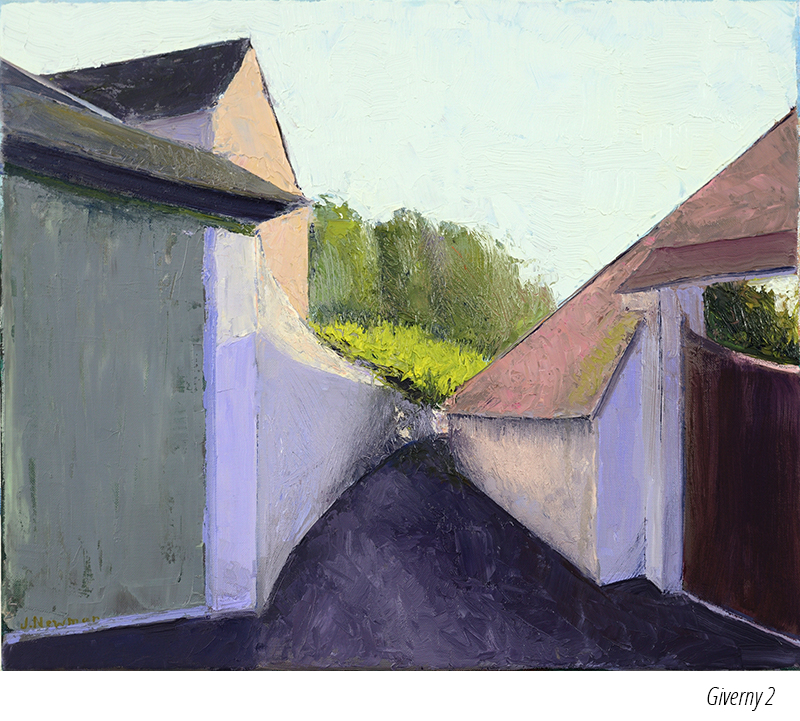
Tell a little bit about how you first got into creating art.
I was a hyperactive child often forced to sit down and be quiet. I learned to transfer my physical impulses inward. Art books, drawing, and building stuff out of junk were the things I turned to. I believe this is why I feel most comfortable expressing myself visually rather than verbally.
An informal art education began early in my life in his grandmother’s library. As a painter and interior decorator, her library had many books filled with Russian academic art, impressionists, post impressionists, expressionists, cubists, and abstractionists. After retirement I studied academic drawing and painting under Iliya Mirochnik, Slava Korolenkov, and at the Bridgeview School of Fine Arts in Queens, NY.
A keystone moment for me as an artist today happened in 1968, at 13 years old. I traveled to San Francisco on a family vacation and visited my uncle Jim’s art gallery, Dilexi. The gallery was known for its avant-guard sensibilities and focused on the contemporary art movements and artists of that time. During my visit, my uncle Jim Newman introduced me to several of the artists the gallery represented that happened to be there. I thought I had met the coolest people on the planet and was immediately captivated by everything and everybody there. I wanted to be like them. I spent the next couple of years doodling op-art on everything, creating all sorts of abstract and surreal dioramas out of anything I could lay my hands on, often stuff from the trash bin.

Plein air is often a humbling experience, but also can be a real confidence booster
What artists or movements have had an impact on you?
Impressionism, cubism, post impressionism, academic, surrealism, abstract expressionism, expressionism, as well as the Art Deco and Nouveau movements.
What themes does your work involve?
I like to work within themes. I’ll experiment a lot looking for new looks while working out ideas until something clicks. I painted my Dream Series paintings through this process.

I only ever work for a true representation of life when I’m painting or drawing figures from life for my own education, practice, and enjoyment
What is important to you about the visual experiences you create?
The highest importance to me is when looking at my completed works I feel a high level of dramatic content in the paintings whether it comes from the chosen subject and how I balanced elements across several spectrums including, high vs. low key, representation vs. abstraction, less vs. more defined shapes, flat vs. modeled, warm vs. cool, high vs. low chroma, etc.
What is the significance of medium and color?
I work 98% in oil but often use gouache, conte stick, and graphite for sketching out ideas or life studies. Depending on the “look,” that I’m going for, I may paint in traditional oils or oil paints based on alkyd resins for their fast drying and transparency qualities. So far as colors go, lately I have been using a CYMK color scheme with as transparent as possible alkyd paints on my pallet and alkyd resin mediums of various viscosities to get the vibrant colors in the dream series.

Do you work from memory, life, photographs, or from other resources?
I go through periods of doing all of that. I began about 12 years ago or so as a “from life,” artist if you don’t count when I was a kid. I go through periods where I paint plain air a lot, especially when I want to judge how much impact recent studio work has had on my painting. Plein air is often a humbling experience, but also can be a real confidence booster. Whenever I’m out and about, I’m taking pictures. I use photo editing software (GIMP) to cut, paste, mix, combine, mess up perspective, change the value structure, mess with the colors, until I wind up with something that I can use as a piece of reference material. Sometimes it only results in an effect that I try to achieve when painting an entirely different subject whether from memory, life or photograph. I only ever work for a true representation of life when I’m painting or drawing figures from life for my own education, practice, and enjoyment.
What is your favorite art accident? Did it change your perspective?
One day I had the thought that creating art is a metaphor for natural selection in evolutionary theory. It absolutely changed my perspective. I came to the conclusion that I must be willing to sacrifice every skill I had acquired regardless of how hard I worked to acquire it or how much it is a part of my artist’s tool kit. My ideas must have the room to compete in my studio. Sacred cows take up space that new discoveries would otherwise occupy.
Do you have any artistic goals for the future that you would like to share?
Artistically speaking, my goals right now are focused on uncovering a new theme and look for my next series of paintings.
What do you consider the role of an artist today?
From what the earliest cave painters shared with members of their tribe to the pure abstraction of the 20th Century took 64,000 years to evolve. Today a painting is available around the world in milliseconds on the internet for other artists, collectors, and people who love paintings.
From those earliest human artists expressing themselves artistically, to their artist descendants today, artistic expression has been a driver of human evolution. The role of an artist today is to continue doing what they do with the knowledge that evolution and natural selection will do what they do, and your art will be a part of it.


